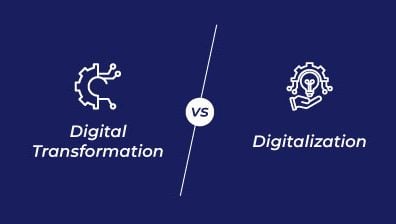In the ever-evolving landscape of the digital world, businesses must adapt or risk becoming obsolete. Digital transformation is not just a buzzword, it’s a fundamental shift that organizations must embrace to thrive in the digital age. This article will delve deep into the nine crucial elements of digital transformation, providing you with the knowledge and insights needed to outrank the competition and stay ahead in the digital race.
Table of Contents
Understanding Digital Transformation
Digital transformation refers to the integration of digital technology into all aspects of an organization’s operations, fundamentally changing how it operates and delivers value to its customers. This transformation encompasses the adoption of various digital tools, technologies, and strategies to enhance efficiency, improve customer experiences, and drive innovation.

Digital transformation encompasses a wide range of elements, including:
- Data Analytics: Data serves as the foundation of digital transformation. Organizations harness data to gain insights into customer behavior, market trends, and operational efficiency. Data-driven decision-making is a fundamental aspect of successful digital transformation.
- Cloud Computing: Cloud technology empowers businesses to rapidly scale their operations, reduce infrastructure costs, and access advanced computing resources. It also facilitates remote work and seamless collaboration, making it a cornerstone of modern digital strategies.
- Automation and Artificial Intelligence: Automation streamlines repetitive tasks, while AI enhances decision-making processes. These technologies significantly improve efficiency and find applications across various business functions, from customer support to supply chain management.
- Customer-Centricity: Placing the customer at the center of digital transformation efforts involves creating personalized experiences, understanding customer preferences, and utilizing data to tailor products and services. Customer-centric approaches drive satisfaction and loyalty.
- Employee Training: Successful digital transformation often necessitates upskilling employees to effectively utilize new technologies. Robust training programs are essential for cultivating a digitally literate workforce, ensuring seamless integration of digital tools and strategies.
The Nine Elements of Digital Transformation
The extent of digital transformation varies among enterprises. Each organization is undergoing a transformation journey tailored to its perceived needs and is experiencing differing levels of success. While a majority have undertaken a comprehensive transformation of their operations, some are still in the early stages, addressing only the fundamentals. The underlying idea is to begin by exploring various digital initiatives that hold significant potential for business transformation before progressing further.
Amidst these disparities, what unites businesses are the common areas included in their transformation agendas. As outlined in the study, organizations have primarily focused on digitally transforming three key elements of digital transformation of their operations:
- Customer experience
- Operational processes
- Business models
These three components collectively constitute the Nine Elements of Digital Transformation.
Customer Experience
To drive a digital transformation in customer experience, businesses have focused their efforts on three specific subcategories.
Customer Understanding
One of the crucial elements that companies have wholeheartedly embraced is Customer Understanding. This element revolves around the relentless pursuit of comprehending the intricate nuances of customer behavior and preferences.
Companies have made substantial investments in both time and effort to delve deep into the psyche of their customers. They employ a bunch of packages of tools and technologies, ranging from social media platforms to advanced customer analytics systems. Through these means, they gain profound insights into their target audience’s demographics, geographical locations, market segments, and the root causes of customer dissatisfaction.

Furthermore, businesses have gone the extra mile by establishing online communities. These digital forums serve as invaluable channels for interaction, drawing them closer to their customers. By fostering these communities, companies not only gain insights but also cultivate relationships and trust, creating a two-way street of communication.
In essence, Customer Understanding is not merely about data collection, it’s about the holistic appreciation of customer needs, desires, and pain points. In the age of digital transformation, this understanding acts as the compass guiding businesses toward tailored experiences and sustainable growth.
Top-Line Growth
Top-line growth stands as a pivotal element that empowers companies to redefine their sales approach and elevate their revenue streams. The realization has dawned upon businesses that the days of monotonous, unengaging sales pitches are long gone. In fact, such pitches not only fail to captivate potential customers but also tend to push them away.
Recognizing this shift in customer behavior, many companies have harnessed technology to refine their sales conversations and pitches. The transition from paper-based documents to tablet and mobile-based presentations marks a significant milestone in this journey. These digital presentations not only captivate the audience with interactive content but also offer real-time updates and customization options, ensuring a more engaging and responsive sales experience.

However, the transformation continues beyond there. To craft more targeted and effective sales pitches, companies are turning to the wealth of insights derived from customer purchasing data. Tools like cloud Customer Relationship Management (CRM) systems are at the forefront of this initiative. They serve as powerful repositories, streamlining vast amounts of customer data, and transforming it into actionable insights.
By analyzing this data, businesses can understand customer preferences, buying patterns, and pain points. Armed with this knowledge, sales teams can tailor their pitches to resonate with the individual needs and desires of each prospect. This level of personalization not only enhances the likelihood of closing deals but also fosters stronger customer relationships and loyalty.
Top-line growth in digital transformation is not solely about boosting revenue figures. It’s about reinventing the sales process, leveraging technology to engage customers, and harnessing data-driven insights to create compelling and personalized sales pitches. This transformation ensures that businesses not only stay relevant but also thrive in an era where customer engagement is the key to sustainable growth.
Customer Touch Points
In a digital-first world, businesses are redefining customer service, offering prompt and personalized interactions across a multitude of customer touch points.
One notable evolution in this sphere is the advent of customer service-based apps. Companies are investing in user-friendly, feature-rich applications that allow customers to access services, seek assistance, and resolve issues seamlessly. These apps are designed to provide a consistent and convenient experience, ensuring that customers can engage with the brand at their convenience, whether it’s day or night.

Moreover, businesses are recognizing the importance of integrating these touchpoints into their internal operational processes. The goal is to provide an integrated service experience across all channels, eliminating silos and ensuring that customers receive consistent support, regardless of the medium they choose.
Customer Touch Points in the context of digital transformation represent a fundamental shift in how businesses approach customer engagement. By leveraging technology and integrating touchpoints seamlessly into their operations, companies are not only enhancing customer convenience but also staying ahead in an increasingly competitive landscape. These initiatives empower customers, ensuring that their needs and concerns are addressed promptly and effectively, ultimately fostering brand loyalty and growth.
Operational Processes
To drive digital transformation in operational processes, businesses have focused on three specific subcategories.
Process Digitization
Process Digitization, often synonymous with advanced process automation, represents a critical element within the broader scope of digital transformation. It’s not merely a buzzword but a strategic approach adopted by businesses to revolutionize their operations.
At its core, process digitization involves the conversion of manual and paper-based processes into digital formats. This shift is driven by a desire to optimize efficiency, reduce errors, and enhance accessibility to critical data. The overarching goal is to liberate resources from routine, behind-the-scenes tasks, allowing them to focus on more strategic and value-added activities.
Companies across industries are leveraging automation tools to realize these benefits. Whether it’s streamlining HR functions, automating data entry processes, or orchestrating complex workflows, the spectrum of applications is vast and continually expanding.

One primary advantage of process digitization is its potential to free up human resources. When routine and repetitive tasks are automated, employees can redirect their efforts toward tasks that require creativity, critical thinking, and strategic decision-making. This not only enhances overall productivity but also fosters a culture of innovation within the organization.
Moreover, process digitization isn’t confined to a single department or function. It permeates various facets of a business, from finance and marketing to supply chain management and customer service. By automating and digitizing processes in these areas, companies can achieve cost savings, reduce operational risks, and respond more swiftly to market dynamics.
In essence, process digitization serves as a cornerstone of digital transformation, enabling organizations to streamline operations, maximize the potential of their workforce, and position themselves for sustained success in an increasingly competitive digital landscape. It’s more than just automation, it’s a strategic shift that empowers businesses to thrive in the digital era.
Worker Enablement
Worker enablement is a trend that initially gained momentum with companies like Google and has now permeated the strategies of top-notch organizations worldwide.
At its core, worker enablement revolves around creating a flexible and dynamic work environment. According to recent studies, a significant percentage of global firms have embraced this approach by reimagining their working and seating arrangements. The traditional concept of fixed workstations has given way to a more fluid model where employees have the freedom to choose where they work, be it from home or the office. There are no rigid seat assignments, instead, employees have the liberty to sit beside colleagues with whom they are currently collaborating.

This flexibility serves several strategic purposes:
- Enhanced Collaboration: By allowing employees to work alongside those they are actively collaborating with, organizations foster greater teamwork, knowledge sharing, and innovation. This collaborative environment is conducive to problem-solving and idea generation.
- Real-Time Communication: Digital tools and technologies facilitate quick and seamless communication within teams. This real-time communication accelerates the resolution of queries and provides immediate access to the right resources. It eliminates bottlenecks in information flow, ensuring that work progresses smoothly.
- Speed and Efficiency: The agile working model speeds up work processes, from the initial conception of ideas to the final delivery of projects. Reduced bureaucratic hurdles and increased autonomy enable employees to make decisions more swiftly, improving overall efficiency.
Worker enablement isn’t just about providing flexibility, it’s about empowering employees to work in ways that best suit their needs and maximize their potential. It’s a strategic move aimed at nurturing a collaborative and innovative workforce capable of driving digital success. By breaking free from traditional constraints and leveraging digital tools, organizations can create a work environment that encourages creativity, problem-solving, and continuous learning, ultimately positioning themselves for success in the digital age.
Performance Management
Performance management represents a significant shift in how organizations operate, make decisions, and drive improvements. This transformation is particularly evident in the realm of transactional systems, which are extensively employed in both internal and customer-facing processes.
One of the key advantages of performance management in this era is the profound insights it provides to managerial executives. In the past, decisions were often based on assumptions or limited data. However, with the advent of advanced data analytics and digital tools, managers now have access to a wealth of real data, enabling them to make informed and strategic decisions.

These insights go beyond surface-level information, they delve deep into aspects such as products, regions, and customer behaviors. Managers have the resources at their fingertips to compare and contrast data in ways that were previously unimaginable. Here’s how performance management revolutionizes decision-making:
- Data-Driven Decision-Making: Managers no longer rely on gut feelings or hunches, they base their decisions on concrete data and analytics. This data-driven approach enhances the precision and effectiveness of decision-making.
- Strategic Planning: With a comprehensive view of performance metrics, managers can formulate long-term strategies that align with organizational goals and market trends.
- Performance Monitoring: Real-time monitoring of performance metrics allows for proactive problem-solving and the ability to make course corrections swiftly.
- Identifying Trends and Opportunities: Performance data highlights emerging trends and opportunities that may otherwise go unnoticed, enabling businesses to stay ahead of the curve.
- Comparative Analysis: Managers can compare performance across various products, regions, or customer segments, identifying areas that require attention or optimization.
The shift towards data-driven performance management is a game-changer. It empowers organizations to thrive in the digital age by fostering a culture of continuous improvement and informed decision-making. In this landscape, assumptions give way to insights, and managers have the tools they need to drive efficiency, competitiveness, and growth.
Business Models
To drive digital transformation in business models, companies have focused on three specific subcategories.
Digitally Modified Businesses
Digitally modified businesses represents a fundamental element of the digital transformative journey, where companies strategically integrate digital mediums and technologies into their operational framework.
There is a widespread adoption of digital tools and channels for content sharing across organizational silos. Rather than completely discarding traditional processes, companies have chosen a path of harmonious coexistence. They have begun harnessing digital channels to drive new avenues of business growth, marking a significant shift in their approach.

Digitally modified businesses reflect an evolving approach to digital transformation. Rather than an all-or-nothing transition, it’s about strategically integrating digital capabilities to augment traditional processes. This synergy between the old and the new results in improved efficiency, customer satisfaction, and overall business growth. It’s a testament to the adaptability and resilience of modern organizations in the face of digital disruption.
New Digital Businesses
New digital businesses extends beyond the realm of optimizing business processes, it entails the introduction of digital products that complement existing lines of traditional offerings. The overarching objective is to transcend established boundaries by venturing into the digital realm, unlocking new avenues for growth and innovation.

The incorporation of digital products alongside traditional offerings represents a strategic pivot for companies across industries. It signifies a willingness to adapt to evolving customer preferences and embrace the possibilities of the digital age. Here’s how new digital businesses are redefining the landscape:
- Diversification: By expanding their portfolio to include digital products, companies diversify their revenue streams and reduce dependence on legacy offerings.
- Enhanced Customer Engagement: Digital products provide fresh opportunities for engaging with customers. They can offer interactive experiences, personalized services, and ongoing connectivity.
- Market Expansion: The digital realm often allows for global reach, enabling businesses to tap into new markets and demographics that were previously inaccessible.
- Innovation Catalyst: Digital ventures stimulate innovation by encouraging experimentation and adaptation to emerging technologies and trends.
- Competitive Edge: Embracing digital products can provide a competitive edge by differentiating a company from rivals and addressing evolving customer demands.
- Agility: Digital businesses are often more agile, and capable of responding swiftly to market changes and customer feedback.
The introduction of digital products doesn’t necessarily replace traditional offerings, rather, it augments and complements them. It’s a strategic shift that allows companies to meet customers where they are in an increasingly digital-centric world. New digital businesses represent a proactive approach to digital transformation, capitalizing on the opportunities that the digital landscape offers to drive growth, innovation, and long-term sustainability.
Digital Globalization
The infusion of digital transformation into the corporate landscape goes beyond optimizing internal processes. Indeed, digital globalization stands out as a transformative element that redefines the way businesses operate and expand. It goes beyond simply integrating digital technologies into existing business processes, it’s about embracing digital products and solutions to complement traditional offerings, thereby broadening horizons and global reach.

The integration of digital is not confined to optimizing internal business processes. Companies are strategically introducing digital products and services to augment their existing lineup of traditional offerings. This strategic move is driven by the desire to break through geographical and operational boundaries by venturing into the digital realm.
In summary, digital globalization is not merely about adopting digital technologies, it’s a strategic shift that redefines a company’s portfolio and its approach to global expansion. By embracing digital products and solutions, businesses can transcend traditional boundaries, tap into new markets, and remain agile and competitive in the ever-evolving digital landscape. It’s a testament to the transformative power of digital transformation in reshaping businesses for the digital age.
The Importance of Embracing Digital Transformation
The nine elements of digital transformation have become a defining factor that separates thriving organizations from those struggling to keep pace with changing times. This transformation goes beyond the mere adoption of technology. Below are five reasons why modern organizations should embrace this approach to stay competitive in this hassle market.
Accelerated Time-to-Market
In the past, companies could afford a leisurely pace when launching products and services. Taking months, or even years, to introduce improvements was common, as long as quality standards were met. However, this approach is no longer tenable. The modern business landscape is marked by fierce competition, both locally and globally. Any delay in bringing a product to market can result in a substantial loss of customers to rival alternatives.

To stay competitive, companies must prioritize continuous operational improvement, particularly in the realm of product development. Time delays must be eradicated. Digital transformation emerges as the solution, streamlining the process of creating and launching products on a global scale. It replaces sluggish manual processes with automation, enhancing response times and allowing for more efficient solution development. Companies must leverage digital transformation to address technology infrastructure deficiencies, minimizing both cost and time-to-market.
Improved Solution Quality
Digital transformation isn’t just about speeding up processes, it’s about elevating solution quality. By embracing digital transformation, organizations establish a supportive infrastructure that fosters quicker and more effective collaboration among departments and employees. This digital integration allows for the utilization of data to derive relevant and actionable insights, enabling agile responses to emerging problems or issues.
Digital transformation equips organizations with the tools necessary for swift solution development and enhancements. It facilitates direct engagement with end-users, providing a platform for collecting and addressing feedback. Organizations can measure and respond to customer complaints, refining their solutions to better meet customer needs.

This approach extends beyond technology companies, even businesses in sectors like restaurants or retail can leverage data to analyze customer purchasing behaviors and proactively address issues.
Furthermore, the ability to continuously develop and enhance existing solutions has become a key driver of success. Companies that embrace an innovative mindset and prioritize ongoing improvement can reduce costs and waste, gaining a substantial market share. Customers increasingly favor cost-effective products and exceptional customer experiences. Without a digital infrastructure, fostering innovation becomes a formidable challenge.
Enhanced Security
Organizations confront a multitude of security threats in their daily operations, making data security a paramount concern for IT leaders worldwide. The increasing focus on data sharing and digital technology amplifies the risk of security vulnerabilities. However, overly rigid access controls and security measures can result in inefficiencies and underperformance.
Consider a scenario where a promising business opportunity slips away due to delayed approvals. To prevent such situations, organizations must implement uniform data security measures across all departments. Additionally, as global businesses adopt hybrid working models, ensuring security on personal devices becomes imperative. A comprehensive digital transformation empowers organizations to address these challenges effectively, enhancing security across the board.
On-Demand Services
Companies now set themselves apart by delivering exceptional customer experiences and raising customer expectations for speedy service and product delivery. Customers anticipate that companies will harness their operational prowess to provide on-demand services. Furthermore, being easily accessible online is a competitive necessity. Online presence serves as a hallmark of reliability and significantly influences customer trust.

Your digital strategy can determine whether you are a customer’s top choice or a last resort. Whether it’s delivering on-demand services or crafting a seamless customer journey, success hinges on a dependable digital infrastructure. Companies must possess high levels of flexibility and efficiency to meet the exacting standards of their target audience. Additionally, navigating a shifting landscape without a robust digital framework is nearly impossible, as employees require modern tools to perform at industry standards.
Enhancing Employee Performance
Employees seek productivity tools to optimize their job performance, a need amplified by the new hybrid working model. Improving productivity and motivation in this context requires a nuanced approach.
Digital transformation offers a solution to address employee concerns. It provides an opportunity to reshape the company’s foundation, freeing core departments like HR and Finance from tedious manual tasks. Embracing automation, productivity, and communication tools such as Odoo, Teams, KissFlow, and more enables seamless integration of digital technology into the organization. These platforms foster enhanced collaboration between teams and departments, expedite decision-making processes, and promote efficient strategies. Additionally, they serve as practical tools for sustaining employee engagement.
In Conclusion,
As you go through this article, you can realize one thing: embracing the nine elements of digital transformation is not merely a choice but a strategic imperative. Each element represents a vital facet of a comprehensive digital transformation strategy, empowering organizations to thrive in the digital age.
When we navigate a future marked by rapid technological advancements, those who embrace the Nine Elements of Digital Transformation are poised to not only survive but also thrive, setting new standards of excellence and innovation in their respective industries. In this digital era, transformation isn’t an option, it’s the path to a brighter, more connected, and more efficient future for organizations across the globe.











